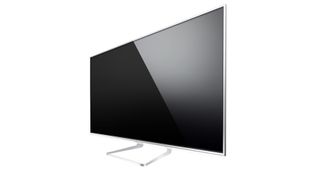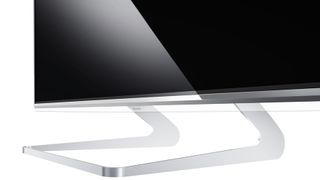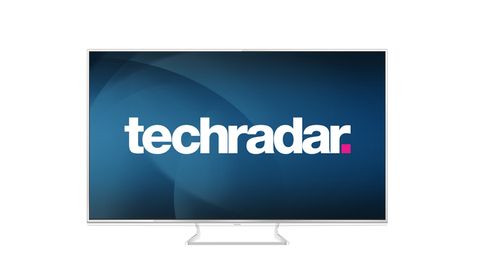Why you can trust TechRadar
3D may appear a fizzled fad, but in the context of 4K it suddenly becomes rather interesting again.
The smoothness of image that an Ultra HD panel brings to stereoscopic pictures is rather compelling. The WT600 employs Active Shutter rather than Passive 3D technology; two pairs of shuttering glasses are bundled.
With upscaled Full HD 3D Blu-rays, the panel delivers a bright, detailed performance. There's some low level of crosstalk double imaging, but it's not overly distracting.
However the use of Active Shuttering does mean that flickering is an issue when viewing amid multiple light sources, though. Sky's 3D channel, which can look rough on Full HD Passive sets, here displays usually good detail and image integrity.

2D image quality
Any doubts about the relevance of a large 4K TV in a Full HD world are swiftly put to bed by the TX-L65WT600.
Its upscaled images have a substance and depth which is little short of mesmerising. There's a pristine clarity to up-rezzed 4K that proves supremely comfortable to watch.
And occasionally, its picture processor clicks with content in a fashion that's just dazzling; detail, texture and contrast find a UHD synchronicity that's jaw-dropping. Lauded US sitcom Louie on Fox may seem an unnatural 4K demo star, but that thing upscales like a trooper.
The set offers a wide variety of image presets: Dynamic, Normal, Cinema, THX Cinema, THX bright Room, Monitor and Custom, in addition to two ISFccc modes.
While the presets cover off the majority of viewing conditions, you can dig deep to calibrate if required. Once a setting has been fine-tuned you can copy it across to specific inputs, be it the DVB tuner or HDMIs. This is quite a handy time-saver.

Image processing
Inevitably, the set incorporates Panasonic's proprietary Intelligent Frame Creation processing.
The natural inclination is to turn this off immediately, although it can prove interesting. On Minimum, there are no overt motion artefacts and for general TV watching it's fine.
Both the Mid and Max setting optimise motion resolution but introduce artefacts. If you engage them, consider your content carefully: a soaring 4K Eagle appeared to have deployed Starfleet shields for protection during our audition, however Sky's F1 coverage came through unscathed, with IFC giving the upscaled, weaving racers astonishing fluidly.
The set's dark level performance is generally very good, and back-light uniformity fine; the set looks its best in low ambient light, when blacks take on profound depth and richness. Colour fidelity is deep and vibrant, however off axis viewing leads to a noticeable drop in saturation and contrast.
While 1080p upscaling looks good, the panel really comes into its own with native 4K. It's only then that the laser-like precision of its eight million pixel image structure truly becomes apparent. And this Panasonic has one further talent currently unmatched by any other 4K display: it is high frame rate compatible.
Unfortunately, while the set boasts an HDMI 2.0 input capable of displaying UHD up to 2160 50/60Hz, there's no output device available to partner with it.
However, the screen also has a DisplayPort 1.2 input, also supportive of 4096 x 2160Hz. This is intended for use with PCs equipped with 4K capable graphics cards, but we used it to hook up a 4K media server, running ultra high definition content at 60fps.

Ultra HD picture quality
The clarity of this next-next gen Ultra HD material is mind-blowing. Our flighty frame-rate footage comprised a travelogue shot in and around California, with come classic cars thrown in for 4K bling, plus test footage shot by Eurosport comprising European Rally highlights and Equestrian clips.
While seals basking on pontoons at Fisherman's Wharf where beguiling in their detail, it was the sports material which really rammed home the benefits of high-frame rate Ultra HD. The astonishing depth and clarity of image, combined with an effortless smoothness, creates an unparalleled illusion of reality.
While the broadcast specification for 4K TV transmission is still under consideration, there's no doubt that the likes of Sky intend to shoot 4K sport at 50/60Hz. If this groundbreaking Panasonic is the first indication of what that will look like, sign us up right now.
The provision of DisplayPort 1.2 would appear to have ramification for gaming as well; a laced-up high-spec PC should be able to comfortably outperform both the PS4 and Xbox One when it comes to video output quality.
The only caveat is the nature of DisplayPort itself. During our audition, we experienced a number of issues that would frankly leave most consumers despairing. The set had profound handshaking issues with our server; as soon as we strayed from the DisplayPort input, the signal was lost and that PC had to be rebooted to resysnc.
We'll take these as early firmware flibbles, and keep our fingers crossed that all will be resolved in due course.
Steve has been writing about AV and home cinema since the dawn of time, or more accurately, since the glory days of VHS and Betamax. He has strong opinions on the latest TV technology, Hi-Fi and Blu-ray/media players, and likes nothing better than to crank up his ludicrously powerful home theatre system to binge-watch TV shows.

Is there a moral imperative for businesses to share data?

Why sovereign AI infrastructure is driving worldwide adoption of Generative AI

Real life 6G speed tests revealed by Japanese tech giants — 100Gb/s transmissions could become the norm for mainstream wireless network data transfer within a few years

